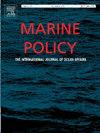管理南极洲生物污染风险的框架
IF 3.7
2区 社会学
Q2 ENVIRONMENTAL STUDIES
引用次数: 0
摘要
入侵物种是对海洋生态系统的重大威胁,导致生物多样性丧失和生态系统变化。生物污染是水生生物在船体上的积累,是世界范围内入侵物种的主要途径之一,入侵物种几乎存在于所有海洋生态系统中。南极洲目前仍然没有已知的海洋非本地物种种群。然而,船只调查已经在南极航行的船只上发现了多种生物污染群落。在这里,我们以南极为背景,评估了世界范围内生物污染指导方针的有效性,评估了一项全面的国际生物污染管理协议是否能使该地区受益。在国际海事组织全球污染伙伴关系指导方针的指导下,以南极条约体系内最近的工作为基础,我们审查了生物污染带来的风险,审查了现有管理战略的适用性,并确定了为南极量身定制的全面生物污染协议的技术要素。建议通过南极条约系统在南极船只的出发港实施基于风险的生物污染政策。鉴于南极船舶活动的增加以及气候变化导致的环境条件的迅速变化,实施具体的生物污染法规将进一步使《南极条约体系》的利益攸关方能够履行其保护南极独特的海洋生态系统和生物多样性的义务。本文章由计算机程序翻译,如有差异,请以英文原文为准。
A framework for managing Antarctica’s biofouling risks
Invasive species are a significant threat to marine ecosystems, contributing to biodiversity loss and ecosystem changes. Biofouling, the accumulation of aquatic organisms on vessel hulls, is one of the main pathways for invasive species worldwide, with invasive species present in nearly all marine ecosystems. Antarctica currently remains free of known established populations of marine non-native species. Vessel surveys have, however, identified diverse biofouling communities on Antarctic-bound vessels. Here, we evaluate the effectiveness of biofouling guidelines in place worldwide, in an Antarctic context, assessing whether a comprehensive international biofouling management agreement could benefit the region. Guided by the International Maritime Organization’s GloFouling Partnership's guidelines and building on recent work within the Antarctic Treaty System, we review the risks posed by biofouling, examine the applicability of existing management strategies, and identify technical elements for a comprehensive biofouling agreement tailored to Antarctica. The implementation of risk-based biofouling policies, through the Antarctic Treaty System in the departure ports of Antarctic vessels is proposed. Given the increasing vessel activity in the Antarctic and rapidly changing environmental conditions as a result of climate change, implementing specific biofouling regulations will further enable the Antarctic Treaty System’s stakeholders to discharge their obligations to protect Antarctica’s unique marine ecosystems and biodiversity.
求助全文
通过发布文献求助,成功后即可免费获取论文全文。
去求助
来源期刊

Marine Policy
Multiple-
CiteScore
7.60
自引率
13.20%
发文量
428
期刊介绍:
Marine Policy is the leading journal of ocean policy studies. It offers researchers, analysts and policy makers a unique combination of analyses in the principal social science disciplines relevant to the formulation of marine policy. Major articles are contributed by specialists in marine affairs, including marine economists and marine resource managers, political scientists, marine scientists, international lawyers, geographers and anthropologists. Drawing on their expertise and research, the journal covers: international, regional and national marine policies; institutional arrangements for the management and regulation of marine activities, including fisheries and shipping; conflict resolution; marine pollution and environment; conservation and use of marine resources. Regular features of Marine Policy include research reports, conference reports and reports on current developments to keep readers up-to-date with the latest developments and research in ocean affairs.
 求助内容:
求助内容: 应助结果提醒方式:
应助结果提醒方式:


